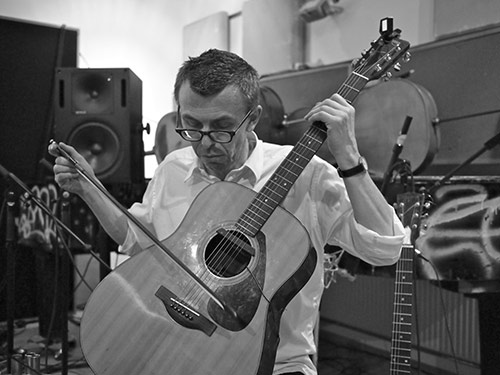Burkhard Stangl

Dr. Burkhard Stangl (b.1960) is a prolific performer in the worlds of electro-acoustic improvisation and contemporary classical music, having participated in over 50 recordings. Lector at the University of Music and Performing Arts (Vienna) for improvisation and new streams in music, author of several books and many articles on cultural anthropology and music theory, among them “Ethnology in the ear. The history of action of the phonograph“ (2000).
MISCS, fixed tape, 23’00″ / 2015.
The title is often the first thing that comes to my mind when I think of a new composition (and sometimes it’s the only thing left of it).MISCS is derived from the beautiful English word misc[ellaneou]s, which means as much as different, diverse, mixed and which provoked in me the following idea: different sounds, which had all been already recorded by pre-digital sound recorders and stored on pre-digital media, should be amalgamated via countless cuts to a hectic, nervous noisy soundscape.
In fact, it was then the digitization of an empty magnetic tape in a pathetic pitifully state that took me on a new trail. For decades untouched,thus never rewound and certainly stored deficiently, this probably originating from the 1940s empty tape was through various chemical processes – especially the archivists feared “Vinegar syndrome” - in the process of slow destruction. Acetic acid released due to high humidity and temperatures had begun an inexhaustible degradation process of the material and on the “actually” empty band resulted in a deletion of non-existent acoustic information with simultaneous stochastic generation of unforeseen data. Without my help, tape music literally emerged in the strict sense of the term; this pulsating objet trouvé sonoreforms part 2 of the composition and is its aesthetic centre, which also primed the other two parts Part 1 and Part 3 – albeit dialectically mirrored.
MISCS is organized in the chronology of its used sound sources. Part 1, preceded by a „foreign body-like“ introduction, consists of subtly modified noise sounds, based on hundreds of historical wax cylinder recordings. Only their beginnings were used: from the beginning to the onset of the actually wanted acoustic information (voice, vocals, instrumental music, animal sounds, etc.),these noise sequences of the phonograms – the beginnings – are cut together in close succession fed with unobtrusive clinking and far away electric guitar drones.
The last part of the piece, Part 3, then mixes “insect-like” condensed point sounds with prehistoric synthesiser sounds and brings melodies and tonality into play.One could interpret this as a counterpoint to the vulnerable noise sounds.
As I said, my plan to create a restless, nervous piece of noise music was nothing, it failed.To some extent the opposite has come out,namely a quiet, with many small details of variation and rhythmic elements interspersed noise soundscape composition. The work on MISCS once again showed me thatthe existing sound source material, substance!, has its own life and can even be more powerful than the originally pursued compositional concept. – And sometimes, the title of a composition will even solve what one had not planned at all.
